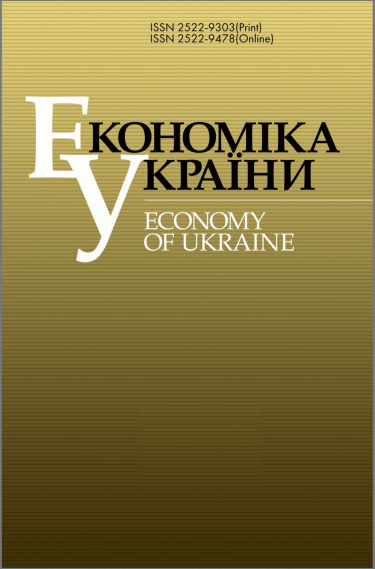CHINA'S BELT AND ROAD INITIATIVE AS A SYSTEMIC TOOL FOR IMPLEMENTING INTERNATIONAL DEVELOPMENT POLICY
DOI:
https://doi.org/10.15407/economyukr.2025.03.021Keywords:
China's strategic initiatives; Belt and Road Initiative; international economic development; international infrastructure projects; international investmentsAbstract
The author analyzes the evolution of China’s Belt and Road Initiative, the main changes in its priorities and implementation mechanisms. It is shown that this initiative has become a comprehensive mechanism for implementing China's development strategy for the 21st century "Community with a shared future for mankind" and an important tool for the formation and development of an alternative model of the globalization process. Three priority trends have been determined in this context: the development of transport (economic) corridors; the creation of an extensive financing network, including the formation of specialized financial institutions; the growing emphasis on new areas of interaction that will technologically shape the future of the world economy.
The article proves that, against the background of substantial achievements in pursuing this initiative, there are a number of impediments to its implementation, which have intensified in the context of the global security crisis and aggravating geopolitical rivalry. Among these are: excessive costs and long implementation periods, low profitability and poor financial resilience of a number of large projects; insufficient involvement of private investors and private investment institutions; the presence of misuse of funds and corruption; the accumulation of considerable debts to China by the countries where such projects are implemented; lack of resources to ensure the highest technological level of projects; insufficient focus on environmental and social standards; considerable disruptions in supply chains. These barriers and challenges may lead to a significant modification of the initiative in the future under the influence of rival policies and institutional formations, changes in the geography of international trade and investment flows.
In the future post-war recovery of Ukraine's economy, the prospects for using the options of the Belt and Road policy will significantly depend on the specific political and economic conditions of post-war development, an objective reassessment of the lessons from the past, and the pragmatic formation of development policy on a new technological basis in a qualitatively new format of globalization processes.
References
Demianchuk, O. (2018). The project «One belt, one way»: Chinese geostrategy. Precarpathian bulletin of the Shevchenko Scientific Society. No. 5. P. 179-186. URL: http://nbuv.gov.ua/UJRN/Pvntsh_2018_5_17 [in Ukrainian].
Sabadan, O. (2018). Belt and Road initiative as a new foreign policy instrument of the People’s Republic of China. Hileya: scientific bulletin. Vol. 137. P. 387-390. URL: http://nbuv.gov.ua/UJRN/gileya_2018_137_98 [in Ukrainian].
Dikarev, O., Shostak, L. (2018). Chinese strategy of «one belt and one way». Market Relations Development in Ukraine. No. 5. P. 69-78. URL: http://nbuv.gov.ua/UJRN/frvu_2018_5_12 [in Ukrainian].
Zakharin, S., Levchuk, N., Li, Y. (2017). Possibilities Chinese-Ukrainian cooperation in the context of the «One zone – one road». International Scientific Journal "Internauka". Series: "Economic Sciences". No. 6. P. 24-28. URL: https://www.inter-nauka.com/ua/issues/economic2017/6/2960 [in Ukrainian].
Smotrytska, M. (2020). Chinese initiative of Belt and Road in Ukrainian realities: accomplishments and failures. Chinese Studies. No. 2. P. 133-144. https://doi.org/10.51198/chinesest2020.02.133
Ji, Zhi, Lymar, V. (2021). Macroeconomic indicators of China in the context of the “One belt, one road” initiative. International Scientific Journal "Internauka". Series: "Economic Sciences". No. 1. P. 49-56. https://doi.org/10.25313/2520-2294-2021-1-6857 [in Ukrainian].
Xiao, Luo (2021). “One belt – one road” initiative in the vector of spreading Chinese values. Current Issues of the Humanities. Vol. 43. Iss. 2. P. 28-33. https://doi.org/10.24919/2308-4863/43-2-5 [in Ukrainian].
Tudoroiu, T. (2024). The Geopolitics of China's Belt and Road Initiative. London; New York, Routledge, Taylor & Francis Group. 326 p. https://doi.org/10.4324/9781032616001
Ehteshami, A., Houghton, B., Liu, J. (Eds.) (2024). China Moves West: the Evolving Strategies of the Belt and Road Initiative. Boulder; London, Lynne Rienner Publishers. https://doi.org/10.1515/9781685859855
Kai He, Feng Liu (Eds.) (2024). China's Bilateral Relations and Order Transition in the Indo-Pacific. Singapore; Hackensack, NJ, World Scientific. 350 p. https://doi.org/10.1142/q0480
Chan, Lai-Ha, Lee, Pak K. (Eds.) (2024). China-US Great-power Rivalry: the competitive dynamics of order-building in the Indo-Pacific. New York, Routledge. 242 p. https://doi.org/10.4324/9781003392958
Li Xing, Javier Vadell (Eds.) (2024). China-US Rivalry and Regional Reordering in Latin America and the Caribbean. Abingdon, Oxon; New York, NY, Routledge, Taylor & Francis Group. 290 p. https://doi.org/10.4324/9781032664941
Ferrana, K. (2024). Why the World Needs China: Development, Environmentalism, Conflict Resolution & Common Prosperity. Atlanta, Clarity Press, Inc. 416 p. URL: https://www.claritypress.com/product/why-the-world-needs-china/
Downloads
Published
How to Cite
Issue
Section
License
Copyright (c) 2025 Publisher PH "Academperiodyka" of the NAS of Ukraine

This work is licensed under a Creative Commons Attribution-NonCommercial-NoDerivatives 4.0 International License.



